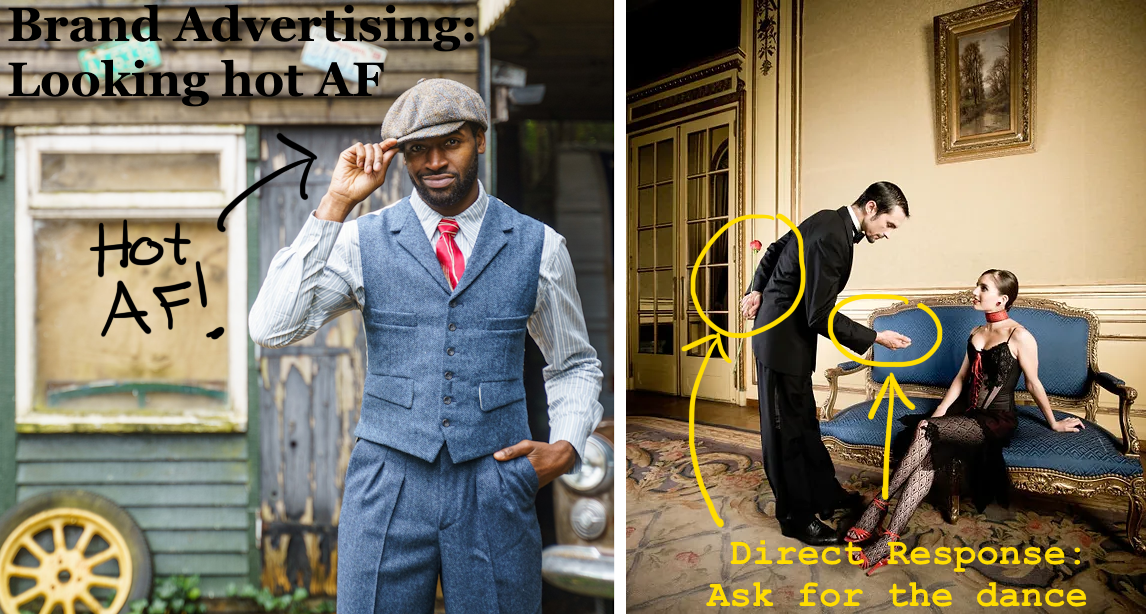Let’s clear up a terrible misunderstanding going round in "make money land" about the fight between direct response (DR) and branding as opposite marketing approaches.
(Short primer on Direct Response Advertising. 2.5 minute read)
DR is known as a short-term approach. Something that makes money now. And it's "common knowledge" that DR stops working.
(That's wrong)
DR is known to try to sell low-value stuff to people who don't want it.
(That's blatantly wrong, too)
No...
Direct response companies are simply making money away from the public eye. The ONLY part of those businesses you see are the highly alluring front-ends that build massive audiences away from publicly available platforms. Those TEND to be the highly excited, wildly colorful (some would say lurid), and long sales pages you see online - selling some amazing product for only 29 American smackeroos.
The trap is: No one can really see a real DR company's size because it's not displayed as a vanity metric. Like the number of followers.
It's hidden, out of sight, as the size of the company's mailing list.
A mailing list that the company can easily advertise to 7x/week with ASTOUNDING results. An approach that leans on lots of plain text emails that are so valuable people will open them day after day is the backbone of every modern business that wants stable cash flow.
So all the namby-pampy "creatives" are out there harping on how DR doesn't work.
But in fact it works EXCEEDINGLY well (and has done so for the last 120 years), it just makes its money where you and I can't see.
Here's How A Direct Response Business Works:
First, Assemble A Highly Receptive Audience:
- Target your advertising towards the exact RIGHT prospects (that’s the job of a skilled media buyer, by the way)
- Sell the living daylights out of products and services that are ACTUALLY valuable and store the email addresses of everyone who purchases from you
Second, Develop Strong Offers
- Sell products people actually want (“branding” marketers think DR is about selling useless shit to unaware audiences. 🤣🤣🤣)
- Go to extreme lengths to build products that are SO GOOD their advertising looks like hyperbole
Third, Keep Writing Highly Enticing Advertising
- Make your advertising itself so valuable so people will keep coming back (Hint: Lead with interesting tidbits, use storytelling, build an identity in your prospects, keep talking about things they always want to read about)
- Deliver on your promises like CRAZY
This works because:
- You’re targeting the right audience
- With increasingly optimized advertising
- That helps pinpoint the kinds of products people are actually willing to pay for
- Which makes selling easier...
- Which builds an enormous list of repeat buyers
- With constant advertising that turns people into raving fans by virtue of overdelivering on your promises, rather than sexy branding and cute slogans

There!
Because…
If you can sell it, then people actually want it.
If people want it, you can make a profit from it.
If you can make a profit from it, you can funnel surplus money into more aesthetically pleasing marketing, later.
And by all means do so.
A biz that has experience with DR marketing that combines direct approaches with branding is going to cream its competitors.
I know of a two-man company that wholesales flour via email, and last I checked that couple made $2 million per year.
With daily emails and a direct response approach mixed with branding.
Because at its core, DR marketing is not about short-term gains, but about doing more of what works.
Case In Point - Extracting Value From Your Audience
This is Katelyn Bourgoin accidentally making a point for DR (Katelyn's a staunch advocate for brand advertising by the way).
ATTENTION IS NOT INTENTION

Exactly!
"...plenty of people who have big audiences and empty walles"
Because they're busy building their audience, not asking for the sale.
The Principles Of Useful Audiences
A big audience doesn't equate to money later. This is a mistake that happens all the time. Build now - monetize later the idea goes.
The problem is that "build now - monetize later" attracts people who'll never want to buy anything.
In other words: It is a common occurence that influencers build audiences of fans who just want to look at them, rather than fans who want to do business with them.
To illustrate: Would you rather have an email list with 200 CEOs on it, or with 20000 people living on welfare?
If you can sell to 10% of your list then you can sell to 20 CEOs at an average price of (AT LEAST) $5000 = $100000
If you can sell to 10% of your list then you can sell to 2000 broke people at an average price of (around) $29 = $58000
This is the "problem" with brand-audience only. You get lots of people who "identify" with your brand, but they're not buying anything from you. There's no "intent" as Katelyn mentioned above.
This is why you use Direct Response marketing: To gauge your audience's intentions.
Because the actions they're willing to take tell you most everything you need to help them in the future.
You can't make money off of things people SAY they will do.
You can only charge them for things they WILL do.
And DR measures the actions that your ideal prospects are actually willing and able to take.
Which them makes them part of your tribe.
So you can sell to them in the future.
Because, what really builds trust is
Making big promises and delivering on them...
If You Would Like To Know If I Can Help You Out Then...
... Book a free chat with me and I'll get you sorted
(Click the link to see how the process works)